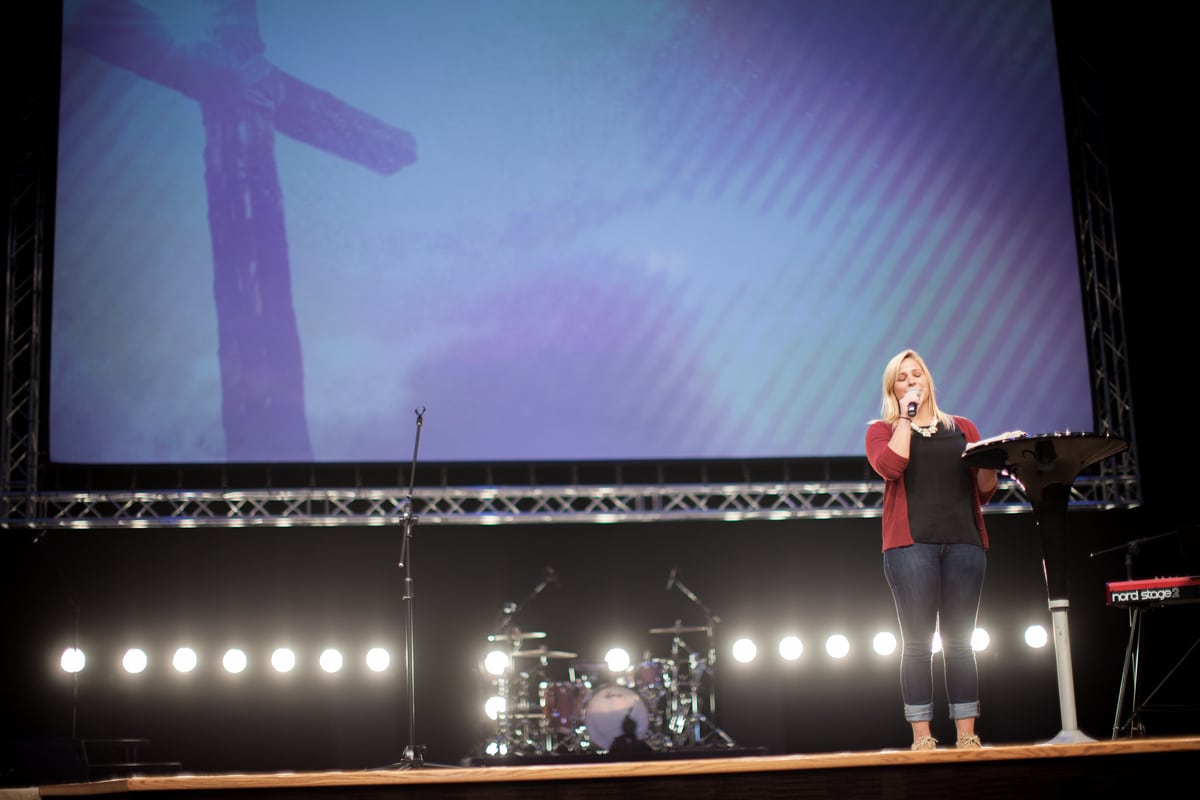Because of live-streaming and/or in-ear monitors, there is a microphone in many churches that isn’t quite intuitive. There are a few similar ideas that go by a few names: the audience microphone, the ambience microphone, the congregation microphone, a room mic…
So, what is this? Why would we want to mic the congregation, or the room?
First, I’ll explain goals for this microphone and then talk about what that might cost. The good news here is that your church can get most of what you need here with microphones you already have laying around.
Before we get going, though, let me address one common misunderstanding about microphones. Even directional microphones are much less directional than you might expect.
Consider putting a vocal microphone on a great operatic singer in a great acoustical space. Perhaps you are using a microphone in a church designed for this sort of thing. In this situation, you might want the microphone to get a bit of the tone of the room. If you only picked up the vocal of the singer, it would be disconnected from this great acoustic space, and that’s half the charm.
Cool. So, how far away would you put that microphone? Ten feet? Five feet? After all, you don’t want the singer’s voice to drown out the acoustics of the room.
Actually…even in this situation, about one foot would pick up plenty of the room. Even two feet will start to get more room than vocal.
Go experiment with this! A directional, vocal microphone is much less directional than many of us imagine.
This matters because an audience mic, and a congregation mic, are all about this balance. You need to have a basic understanding of this principle.
LEVEL 1: Room Microphones
There is a curious phenomenon in a recorded worship service, or a live-streamed worship service. In fact, this is one of the key differences between mixing audio for your in-person worship service and the online worship.
Consider the sermon during your in-person worship. How many microphones should be turned on? Just one, right? The preacher’s microphone should be on. All others should be off. Perfect. Easy. If you do that, everything sounds right.
But if you do that during online worship…it sounds weird. Why? Because viewers at home, subconsciously, expect to hear “the room” the worship service is in. It’s a subtle difference, but you can hear the problem in the sermon here. On the other hand, here’s an example where you can subtly “hear the room.”
What does it mean to “hear the room?” It means you can very slightly hear the acoustics of the space you’re in. Now, if you hear that a lot, it can be overwhelming and make the sermon difficult to understand. It will sound like too much reverb. But that’s an easy problem to solve; just don’t blend in much of the microphone you use to “mic the room.” Generally, a room mic is blended in at 20db below what normal vocal microphones are, or so. Pretty quiet! But it works.
Placement: So, how do you set up a room microphone to accomplish this goal? You can literally put a microphone (or two, if you’re in stereo) almost anywhere in the room, as long as it’s not being blasted by your speakers or too close to any individual congregant. If you’re too close to a specific person, you’re going to get their coughs, etc. Ideally, these microphones are vaguely similar to where people are, and so not up in the rafters.
Aesthetics: If you can achieve these things, then worry about aesthetics! Hide them behind fake plants or near TV screens.
Which Microphone to Use: Truthfully, this can be done reasonably well by most directional microphones. If you want to start doing this with a small budget, use whatever you have at church already. If you’re going to buy microphones for this task, get small diaphragm condensors. Or, better yet, if you’re buying microphones, consider leveling up to Level 2!
LEVEL 2: Congregation Microphones
Level 2 accomplishes the “room mic” goals of Level 1 and adds a bit. Don’t you love hearing the people around you sing along at church? Level 2 moves to a congregation microphone and consciously tries to pick up the sound of your congregation.
So, what’s the difference? First, a congregation microphone has more specific needs than a room mic. You’ll want very directional, shotgun microphones for this. Second, you’re consciously pointing microphones at people. For a room mic, you don’t necessarily need to do that.
What kind of microphone: Use a shotgun microphone. Why? Because even a shotgun microphone will pick up plenty of room sound (and accomplish your Level 1 goals). It’s practically impossible to avoid it! So, you don’t have to worry about that. Instead, focus on ensuring you get as much congregation vocal relative to the room sound. The easiest way to fail in picking microphones for this job is to not get enough congregation in the microphone. So, use a shotgun microphone.
Where to put them: This is the hard part. Ideally, you want to find a spot in your sanctuary maybe 8-15 feet away from specific congregants. However, you may have to do your best here, compromising with aesthetics.
However, you must remember that the farther away from the congregation, the more you are simply micing the room and not the congregation. Do not place closer than about five feet. Any closer than that, and you are simply picking up three or four people.
For reference, shotgun mics used for filming during a documentary interview are about one foot from the mouth of the interviewee. The goal there, of course, is to record one person very cleanly.
Also, the microphones need to be in front of the congregation. Room mics can be behind the congregation, but congregation mics need to be in front of them (so the people are singing, more or less, into these microphones).
How to Use Them: These microphones also should be blended in fairly quietly, and not for your in-person worship speakers. That would be a feedback nightmare. Only use these for online worship or in-ear monitors. Leave them on the entire service, and they’ll continue to serve as room mics, even when the congregation is quiet.
Stephen Hale is the owner of Capital Hope Media, an uncommon communications company for faith-based organizations, www.capitalhopemedia.com. Their all-in-one communications company can help your nonprofit connect more effectively with donors, parishioners, participants and neighbors.













